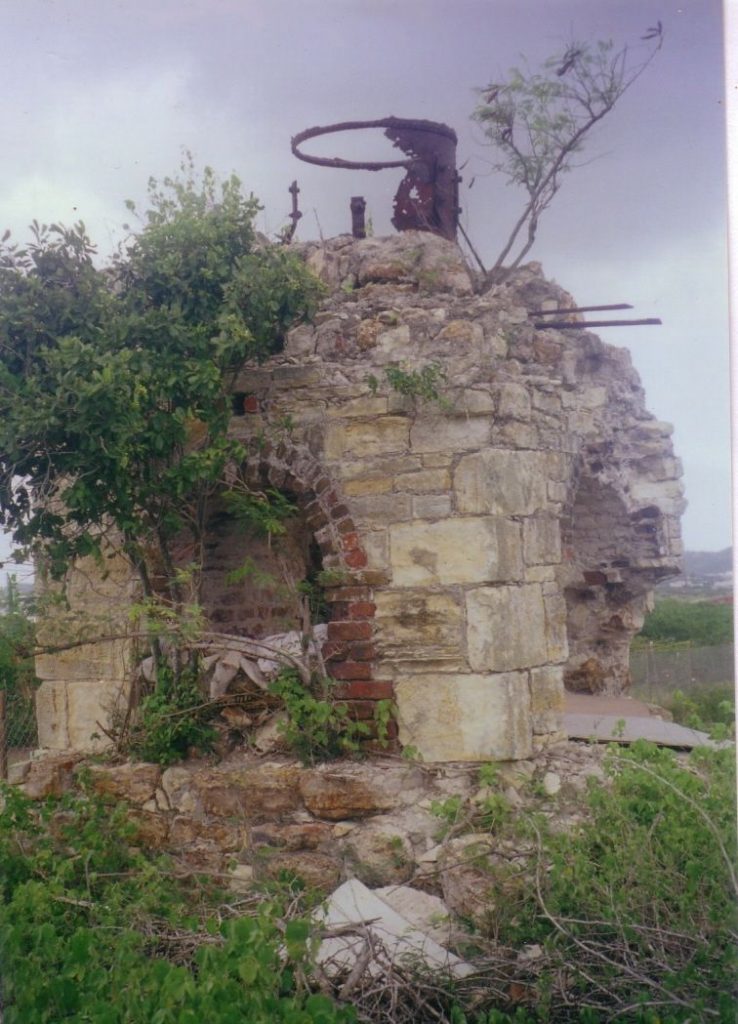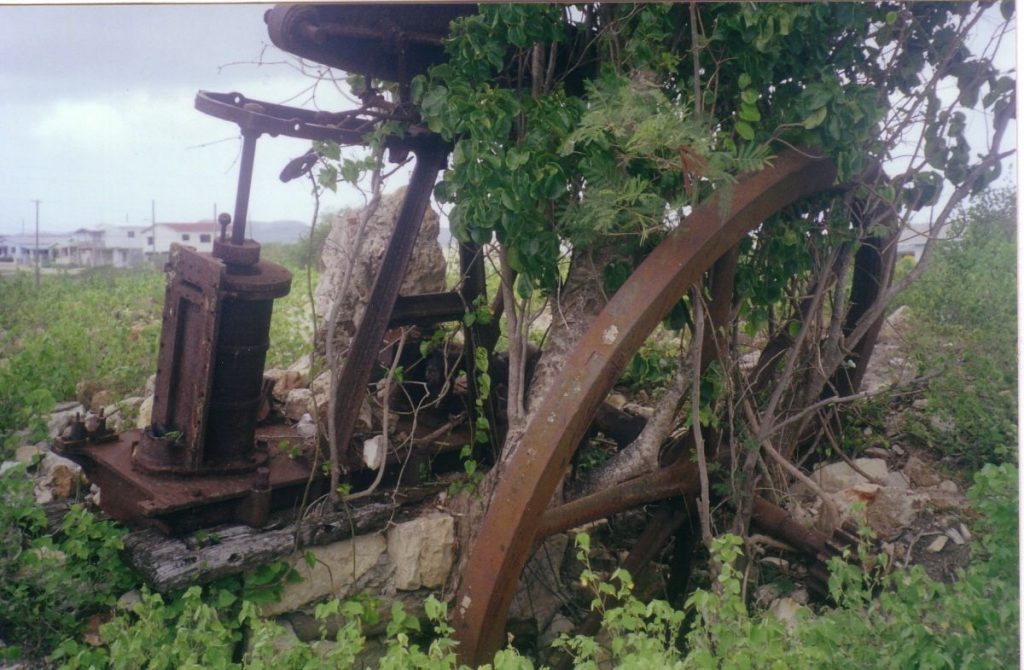About
Type: Ruin
Parish: St.George
Founding date: 1715
See on Google Maps!


Current Status:
There is no longer a mill at this site. There are, however, signs of the Estate, stone walls, and old machinery which is being overtaken by an ever-expanding extension of Seaview Farm known as Lightfoot. A succession of dams separated the Lightfoot area from Gunthrope’s which were used during crop time at the factory. A lot of water was required, and a pump house used to exist just to the corner of the bridge crossing over between two dams. The road itself used to be a dirt road, almost a cane break, which led to the village of Seaview Farm where a lot of the workers from the factory lived.
Estate History/ Timeline:
1715: “I should not do justice to Lord Archibald Hamilton, youngest son to the Duke of that same name if I did not assure you that he has shown more prudence and conduct than perhaps was ever seen in so young a gentleman, and as much bravery as any man living.” Codrington echoed these sentiments when he wrote from Antigua. The Hamilton family came from a long line of Scottish Politicians starting with Lord Archibald Hamilton (1673-1754), Douglas Hamilton (1740-1829), Lord Archibald Hamilton (1769-1827), Archibald Hamilton (1790-1815), and Sir Archibald Hamilton (1878-1939). The 1777-78 map by John Luffman shows the Hon. B. Lightfoot owning a plantation known as “Harts” in this area.
1805: Henry Benskin Lightfoot was born c.1747 and died in 1805 in Virginia. His obituary appeared in the newspaper, Enquirer, Richmond, Va. “Hon. Henry Benskin Lightfoot, late of the island of Antigua, aged about 58 years who died in Richmond on Oct 20th, 1805.” He was a factor for Dreghorn, Murdoch & Company in Prince Edward Co. Va., before the Revolution but, refusing to join the American cause, was given a permit on 22nd March 1776 to leave the colony and settled in Antigua where he married Ann Moore in 1777. He also freed a number of slaves, namely: a mulatto man named William Hillhouse, a carpenter, two negro women named Long Betty and Flora, House servants, two negro women named Lydia and Margaret (washers), and a negro man named Johnny (a groom), leaving them also “their usual allowance of food and clothing from my plantation called the Grove and be permitted to live thereon during their respective lives without interruption or molestation provided they behaved themselves orderly and properly.” Makes reference to a “reputed natural [i.e., illegitimate] daughter baptized by the name of Juliana the natural Daughter of Aspasia Merrick” (who herself was the reputed natural daughter of one Thomas Oliver Merrick) “who formerly lived with me as housekeeper” [ie., Henry impregnated his housekeeper] – in any case, he left Juliana £5,000 (and a bunch more), and once she was 21 or married, many slaves and profits derived from them (see below). He also says of her “And to the end that the education of my said reputed natural Daughter Juliana may be complete in all respects to render her a well-informed woman, it is my earnest request that as soon after my decease as may be convenient she be sent to England and placed at some respectable School noted for the good education and care of female children and the allowance for her maintenance and education be liberal and fully sufficient for the purposes aforesaid. He bequeaths a number (34) of slaves to friends (and above Nicholas), named Tom, Harman, Toney, Goodloe, Harpur, Dick, John, Jacob, Pero, Temple, Stapford, Commodore, Glasgow and Dubling being Caulkers by Trade and now employed in his Majesty’s yard at English Harbour, an apprentice Hamilton, Mulatto Harry Coleman, Neptune, Frank, Mulatto Dick Brown, being carpenters now also employed at English Harbour; Virgil, Tom, Justice and Cromwell being apprentices to carpenters; Mulatto Cudjoe, Mulatto Billy Spa[ ?], Harry Ponto, Richmond, and black Cudjoe, being Masons, and also employed at English Harbour; Aberdeen, Moco Tom, Little Jack, Mitford, being Labourers also employed at English Harbour; and Lefebur, Archy, Meyrick and Richard being boys who I desire may be put to trades… and also seven negro slaves following, that is to say Mimba, Barbara, Mercey, Creet, Lou, polly a washer with her three children Murphy, Frankey and Joe, together with the issue or increase of the females of said slaves… “Three of my plantations in Antigua, The Grove, Mercer’s Creek & Hawes the trustees (as above)…etc.” His rather lengthy will go on to give the remainder of his estate, including the Grove, to his friends John Burke, William Butler, Daniel Hill the younger, Thomas Rogers, Langford Lovell Hodge, George Poindexter, Nicholas Lightfoot and unto the eldest son of my brother Francis Lightfoot who shall be living at the time of my decease… I have added “The Grove” to this site after looking at several maps discerning that it could be the same area. Ownership records for The Grove show from 1878 Henry J. Cassin noted of the island of Nevis” and married Catherine Watts, widow, 1819. Of note, Freida Cassin is one of the first female writers in the West Indies with her book “Silent Tread,” a story about leprosy, first published in Antigua around 1890.
1829: Gunthorpe’s contained 690 acres and had 280 slaves.
1933: Records show A. Harper as owner. The Harper family is one of the old and most respected original families in Antigua, showing William Harper (1790-1847) born in Antigua but died in S. Carolina, he immigrated to America where he moved to Charleston and became a politician working for the rights of South Carolina and was in effect, pro-slavery for the benefit of what he believed to be the economy of the state. Harper’s is still a well-known office supply store in Antigua today founded in 1879 when Alvaro Bento took it over in 1958. In 1915 RBC(Royal Bank of Canada) opened for business in St. John’s in a two-story wooden building owned by the Harper family (proprietors of Harper’s Drug Store). After two years moved to High and Market Streets. The Elizabeth ‘Bessie’ Harper Scholarship fund to pursue higher education was established in 1984. The Edward family pedigree can be found on their genealogical site in particular Thomas Edwards of Comfort Hall b.1748, up until the mid 1900’s. I could not find a Benjamin Edwards. Near another small gulley parallel to Stony Hill Gulley in the old Lightfoot’s Estate is a small burial area. Only two small headstones are still visible, albeit lying down and half buried. One bears no discernible name, but a very discernible date “25th November Anno Domino 1683”. The one next to it in the same old style of character states “…… 17th December …..Here Lyeth Interred the Body of Capt. William Abrainn., and as a large skull and crossbones head the stone, perhaps he was a pirate! Taken from “Heritage Landmarks” by Desmond V Nicholson.
1941: Antigua Sugar Factory, Ltd. Cane Returns for 1941 Crop. Estimated 350 tons, – acres estate, – acres peasant land on the estate, tons of cane delivered 410 at – tons per acre. In 1921 approximately 633 acres.
Enslaved People’s History
Based on contemporary research, we have little information to share about the enslaved peoples from this plantation at this time. Henry Lightfoot in 1805 freed several of his slaves known by their first name. We only know that Gunthorpe’s contained 690 acres and had 280 enslaved people in 1829. We will continue our quest for more information about these vital individuals.
Ownership Chronology
- 1750: Heirs of Archibald Hamilton
- 1777: Henry Benskin Lightfoot (1747-1805) – 1777/78 Luffman map
- 1805: John Burke, William Butler, Daniel Hill, and several other friends as listed in his will
- 1878: Henry J. Cassin 1872
- 1933: A. Harper 1933
- 1971: Benjamin Edwards.